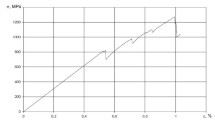Abstract
It has been established that the optimum degree of mechanical property enhancement by fibre reinforcement of a typical thermoplastic material (polyamide 6.6) is achieved if comparatively long fibres are used, the fibre length required being determined by the properties of the interface between the fibre and the thermoplastic matrix. The extent of stiffness improvement at low strains is described by simple modifications to the law of mixtures to allow for fibre orientation and length. The strength enhancement is limited by an embrittlement effect which reduces the strain to fracture as the stiffness of the composite is improved. The cause of this effect has been identified as matrix crack formation at the ends of the reinforcing fibres. At strains of between 0.5% and 1.0%, according to fibre type, length andV f, cracks form at the tips of the longest fibres aligned in the straining direction. Subsequently as the strain is increased more cracks form progressively at the ends of shorter and/or more misaligned fibres. It has been shown that initially this cracking can be accommodated by load transfer to adjacent fibres which “bridge” the cracked region. Final failure occurs when the extent of cracking across the weakest section reaches a critical level when the surrounding fibres and matrix can no longer support the increasing load.
Similar content being viewed by others
References
W. H. Bowyer andM. G. Bader,J. Mater. Sci. 7 (1972) 1315.
M. G. Bader andW. H. Bowyer,J. Phys. D. 5 (1972) 2215.
W. H. Bowyer andM. G. Bader,Faraday Spec. Disc. 2 (1972) 165.
P. T. Curtis, Ph.D Thesis, University of Surrey, (1976).
W. H. Haynes andT. L. Tolbert,J, Composite Mater. 3 (1969) 709.
M. G. Bader andP. T. Curtis, Conference on The Mechanical Performance of Polymers, Soc. Chem. Industry, January 1977. (Proceedings to be published in theBrit. Polymer J.)
H. L. Cox,Brit. J. Appl. Phys. 3 (1952) 72.
A. Kelly, “Strong Solids”, (Clarendon, Oxford, 1973).
A. Kelly andW. R. Tyson,J. Mech. Phys. Sol. 13 (1965) 329.
H. Krenchel, “Fibre Reinforcement” (Akademisk Forlag, Copenhagen, 1964) p. 11.
G. A. Cooper, “Micromechanics Aspects of Fracture and Toughness”, from “Composites” Vol. 5, edited by L. J. Broutman and R. H. Krock Academic Press, New York and London, (1974) p. 415.
R. M. Barker andT. F. Maclaughton J. Composite Mater. 5 (1971) 492.
M. G. Bader, P. T. Curtis andR. S. Chhatwal, AIME International Conference on Composite Materials, Geneva (1975).
Author information
Authors and Affiliations
Rights and permissions
About this article
Cite this article
Curtis, P.T., Bader, M.G. & Bailey, J.E. The stiffness and strength of a polyamide thermoplastic reinforced with glass and carbon fibres. J Mater Sci 13, 377–390 (1978). https://doi.org/10.1007/BF00647783
Received:
Accepted:
Issue Date:
DOI: https://doi.org/10.1007/BF00647783




